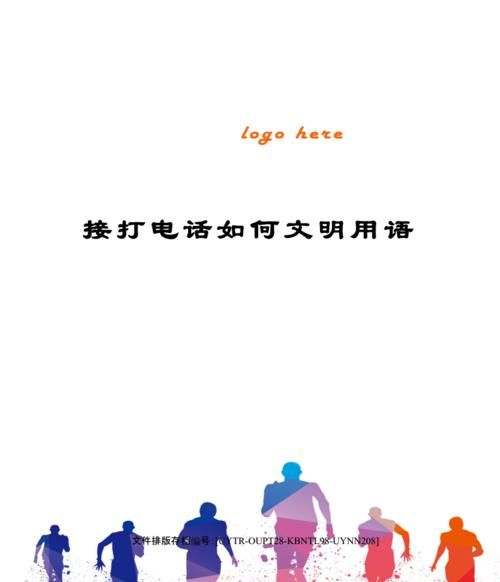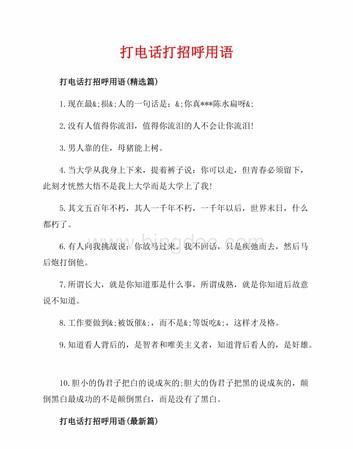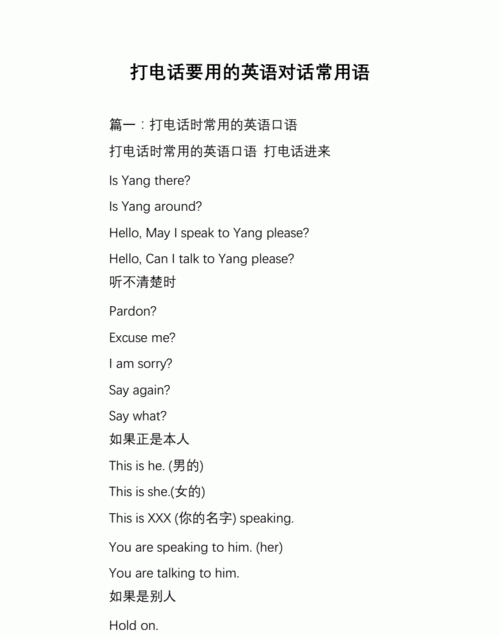本文目录
英语中打电话的基本用语
接电话This is .. speaking . May i speak to ..?
Who is calling ?
I am sorry she is not in at the moment , may i take a message ?
It is ok .i will call back later .
I am sorry ,you have the wrong number .
情况 (一) 打电话的人找的是你自己
打电话来的人
你 (接电话的人)
Is Daisy there? (Daisy 在吗?) Speaking. 我就是.
This is she. 我就是. (注: 男的用 "This is he.")
You're speaking/talking to her. 你正在跟她说话. (注: 男的用 "You're speaking/talking to him.")
This is Daisy. 我就是 Daisy.
That's me. 我就是.
情况 (二) 打电话的人要找的人不在
打电话来的人
你 (接电话的人)
May I speak to Mr. Gates? (请问 Gates 先生在吗?)
He's not here right now. 他现在不在这里.
He's out. 他出去了.
He's in a meeting right now. 他现在正在开会.
You've just missed him. 你刚好错过他了.
He's just stepped out. 他刚好出去了.
情况 (三) 打电话的人要找的人不在, 问对方是否要留言
打电话来的人
你 (接电话的人)
Can I talk to Mark? (我可以跟 Mark 讲话吗?)
He's out on his lunch break right now. Would you like to leave a message? 他出去吃午饭了, 你要留言吗?
He's not available right now. Can I take a message? 他不在, 我可以帮你传话吗?

初中英语日常交际用语
第一个网页
***/r4-article-21159.html
初中英语试用修订大纲交际用语简表
大纲要求的日常交际用语涉及30个方面的内容,现归纳如下:
(1) 问候Greetings(包括Good morning/afternoon/ evening. Hello/ Hi. Fine, thank you. And you? Very well, thank you. How do you do? Nice/ Glad to meet you?)
(2) 介绍 Introductions (包括 This is…, My/ Her/ His name is…, She/ He is…etc.)
(3) 告别Farewells (包括 I think it’s time for us to leave now. I must go now. Goodbye!/ Bye-bye/ Bye! See you later/ tomorrow…, Good night. etc.)
(4) 打电话Making telephone calls. (包括Hello! May I speak to …? Hold on, please. He/She isn’t here right now. Can I take a message for you? Could you like to leave a message? Who’s that? This is … speaking. Is that …?)
(5) 感谢和应答 Thanks and responses (包括Thank you very much. Thanks a lot. Many thanks. Thank you/ Thanks for…. Not at all. That’s all right. You’re welcome.)
(6)祝愿、祝贺和应答 Wishes, congratulations and responses (包括Good luck! Best wishes to you. Have a nice/ good time. Congratulations! Thank you. Happy New Year! Merry Christmas! Happy birthday to you. The same to you. Me, too.)
(7) 表达意愿Intentions (包括I’m going to …, I will…, I’d like to …, I want/ hope to…)
(8) 道歉和应答 Apologies and responses (包括I’m sorry. Sorry. I’m sorry for/ about…. Excuse me. That’s all right. It doesn’t matter. That’s nothing.)
(9) 遗憾和同情 regrets and sympathy (包括What a pity! I’m sorry to hear….)
(10) 邀请和应答 Invitations and responses (包括Will you come to…? Would you like to…? Yes, I’d love to…. Yes. It’s very kink/ nice of you. I’d love to, but….)
(11) 提供(帮助等)和应答 Offers and responses (包括Can I help you? What can I do for you? Here, take this/ my…. Let me… for you. Would you like some…? Thanks. That would be nine/fine. Thank you for your help. Yes, please. No, thanks/thank you. That’s very kind of you, but…)
(12) 请求允许和应答 Asking for permission and responses {包括May I …? Can/ Could I …? Yes/Certainly. Yes, do please. Of course(you may). That’s OK/ all right. I’m sorry, but…. You’d better not}
(13) 表示同意和不同意 Expressing agreement and disagreement (包括Certainly/ Sure/ Of course. Yes, please. Yes, I think so. That’s true. All right/ OK. That’s a good idea. I agree with you. No, I don’t think so. I’m afraid not. I really can’t agree with you.)
(14) 表示肯定和不肯定 Expressing certainty and uncertainty (包括I’m sure. I’m sure that…. I’m not sure. I’m not sure whether/if…. Maybe/Perhaps.)
(15)喜好和厌恶 Likes and dislikes (包括I like/ love… very much. I like/ love to …. I don’t like /like to …. I hate/ hate to….)
(16)谈论天气 Talking about the weather (包括What’s the weather like today? How’s the weather in…? It’s fine/cloudy/ windy/ rainy, etc. today, isn’t it?)
(17)购物 Shopping(包括What can I do for you? May/ Can I help you? I want/ I’d like…. How much is it? That’s too much/expensive, I’m afraid. That’s fine. I’ll take it. Let me have… kilo/ box, etc. How many/ much do you want? Do you have any other kind size colour, etc.?)
(18)问路和应答 Asking the way and responses(包括Excuse me. Where’s the men’s/ ladies’ room? Excuse me, can you tell me the way to…? How can I get to…? I don’t know the way. Go down this street. Turn right/ left at the first/ second crossing. It’s about… metres from here.)
(19)问时间或日期及应答 Asking the time or date and responses(包括What day is it today? What’s the date today? What time is it? What’s the time, please? It’s Monday. It’s January 10th. It’s half past five. It’s time for….)
(20)请求 Requests(包括Can/Could you… for me? Will/ Would you please…? May I have…? Please give/pass me…. Please wait here/ a moment. Please wait for your turn. Please stand in line/line up. Please hurry.)
(21)劝告和建议 Advice and suggestions(包括You’d better…. You should…. You need to…. Shall we…? Let’s…. What/ How about…? Why not…? Why don’t you…?)
(22)禁止和警告 Prohibition and warnings(包括You can’t/ mustn’t…. If you…, you’ll…. Take care! Be careful! …, or you….)
(23)表示感情Expressing certain emotions(包括a. 喜悦Pleasure/ joy I’m glad/pleased/happy to…. That’s nice. That’s wonderful/great. b. 焦虑 Anxiety What’s wrong? What’s the matter(with you)? I’m/He’s/She’s worried. Oh, what shall I/ we do? c. 惊奇 Surprise Really? Oh, dear! Is that so?)
(24)就餐 Taking meals(包括What would you like to have? Would you like something to eat/drink? I’d like…. Would you like some more…? Help yourself to some…. Thank you. I’ve had enough. Just a little, please.)
(25)约会 Making appointments(包括Are you free this afternoon/evening? How about tomorrow morning/afternoon/evening? Shall we meet at 4:30 at…? Yes, that’s all right. Yes, I’ll be free then. No, I won’t be free then. But I’ll be free…. All right. See you then.)
(26)传递信息 Passing on a message(包括Will you please give this note/message to…? …asked me to give you this note. Thanks for the message.)
(27)看病 Seeing the doctor(包括 There’s something wrong with…. I’ve got a cough. I feel terrible /bad. I don’t feel well. I’ve got a pain here. This place hurts. Take this medicine three times a day. It’s nothing serious. You’ll be all right/well soon.)
(28)求助 Calling for help (包括 Help! Can you help me? What’s the matter?)
(29)处理交际中的障碍 Language difficulties(包括 Please say that again/ more slowly. What do you mean by…? I’m sorry I can’t follow you. I’m sorry I know only a little English.)
(30)常见标志和说明 Some common signs and instructions包括:
BUSINESS HOURS, OFFICE HOURS, OPEN, CLOSED, PULL, PUSH, ON, OFF, ENTRANCE, EXIT, INSTRUCTIONS, FRAGILE, THIS SIDE UP, MENU, NO SMOKING, NO PARKING, NO PHOTOS, DANGER!, PLAY, STOP, PAUSE.
对这块内容的复习,我认为做如下处理会有较好的效果,供老师们参考:
首先,要求学生熟读、理解并记住交际用语简表中所列的日常交际用语;
其次,要求学生熟读并背诵初中英语所学的教材中所出现的对话材料(共有166段),勾画出大纲中要求掌握的日常交际用语,以达到进一步巩固的目的;
再次,指导学生运用交际用语简表中所列的日常交际用语自编简短对话,以达到灵活运用的目的。
最后,结合近几年毕业、升学考试试题中的交际应用试题设计题型进行针对性的训练。
找到的第二个网页
***/101resource004/wenjianku/200415/101ktb/lanmu/XF2E0083/XF2E0083.htm
一、Making telephone calls打电话
1. 常见用语
a. 请找某人接电话
Hello! May / Could /Can I speak to …, please?
b. 问对方是不是某人
Is that… (speaking)?
c. 问对方是谁
(1)Who”s speaking / calling?
(2)Who”s that (speaking / calling)?
(3)May / Could I know who”s speaking / calling?
d. 告诉对方自己是谁
This is …(speaking / calling).
e. 要找的人不在,问对方是否留言
(1)Shall / Can I take a message for you?
(2)Would you like to leave a message?
f. 让对方不要挂断
(1)Hold on, please.
(2)Hold the line.
(3)Wait a moment.
2. 要点解析
(1)打电话时,指自己用this,指对方用that。
(2)打电话的开头语为“Hello!”结束语为“Goodbye!”。
3. 考题精选
选择最佳答案完成对话
(”03 北京)
(A. This is Li Ming.
B. Good night.
C. Can I speak to Yang Lin, please?
D. I”m sorry to hear that.
E. I”m sorry I can”t come.)
A. Hello!
B: Hello !__________(1)
A: Just a minute. May I ask who”s calling?
B: __________(2)
A: Hold on, please. Your call. Yang Lin. It”s from Li Ming.
C: Hi, Li Ming. This is Yang Lin speaking.
B: Hi, Yang Lin. Thank you for asking me to your party. __________(3)You see, my sister is sick and I have to stay home with her.
C: __________(4)I hope it”s not serious.
B: Not really. She is already a bit better now.
C: Glad to hear it. Please tell your sister I hope she gets better soon. Thanks for calling. Good night.
B: __________(5)
(Keys: 15. CAEDB)
二、Thanks and responses感谢和应答
1. 常见用语
(1)Thank you (very much).
(2)Thanks a lot.
(3)Many thanks.
(4)Thanks for…
(5)Thank you all the same.
(6)It”s very kind of you.
2. 常见答语
(1)That”s OK. (2)That”s all right
(3)That”s nothing. (4)Not at all.
(5)You”re welcome. (6)It”s a / my pleasure.
(7)Please don”t mention it.
3. 要点精析
(1)英美人接受邀请、祝愿(贺)或收受礼物、受到赞扬等场合时,均要使用感谢用语。
(2)当向对方询问信息时,即使对方不知道,也要礼貌地说明“Thank you all the same.”。
4. 考题精选
(1)Your dress is very beautiful, Mary.
____________.
(”03河北)
A. Not at all B. Just so-so
C. No, it isn”t D. Thank you
(2)Thank you very much.
_____________.
(”03湖南)
A. No, thank you B. I think so
C. Yes, please D. That”s all right.
(3)Hi, Mrs mott. Let me carry the bag for you.
_________ I can carry it myself.
(”03浙江)
A. No, thanks. B. Yes, please.
C. Certainly. D. Why not?
(4)Your dress is just wonderful!
__________.
(”03江苏)
A. You are right, thank you.
B. Thank you, and you?
C. No, no, yours is better.
D. Thank you. I”m glad to hear that.
(Keys: D,D,A,D)
三、Wishes, congratulations and responses 祝愿、祝贺和应答
1. 常见用语
(1)Good luck (to you)!
(2)Best wishes to you!
(3)Have a good/ nice ./ wonderful time!
(4)Congratulations!
(5)Merry Christmas!
(6)Happy New Year!
(7)Happy birthday to you.
(8)Wish you good health and happiness.
2. 常见答语
(1)Thank you.
(2)The same to you.
(3)Thank you, and you too.
3. 要点分析
(1)在英美国家,朋友过生日、升学、乔迁、获奖等场合,人们都要表示祝愿或祝贺,希望对方愉快或与对方分享快乐。
(2)对公共节日的祝贺和祝愿,答语常是“The same to you.”;对生日等的祝贺或祝福,答语常为“Thank you.”。
4. 考题精选
(1)I won the high jump yesterday.
__________.
(”03呼和浩特)
A. It”s a small thing B. That”s all right
C. I hope so D. Congratulations to you
(2)Good luck and have a nice weekend.
__________. Bye-bye.
(”03广州)
A. The same to you B. You have it too
C. You are too D. The same as you
(3)Have a good journey home, David.
___________.
(”03大连)
A. Thank you B. You”d better not talk
C. Well done D. What a pity
(Keys: : D,A,A)
第三个网页 交际用语100题
***/shiti/softdown.asp?softid=2974
这里可以下载 已经测试

被老师打电话说了怎么办
1、给老师打电话时,接通后第一句话:“您好,现在方便吗?我是XXX的父亲(母亲)……”
由于老师一般比较忙,而关于孩子的话题,也不是三言两语就能说清的,因此家长最好先问下老师有没有时间,不要一上来就喋喋不休。如果老师暂时没时间,不妨和老师约定一个时间,这样彼此才能更好的沟通,沟通后的收获也会更多。
2、客套话少说,别一上来就拍马屁。
平时在班级群里拍马屁就算了,但如果在和老师沟通时还不断地拍马屁,只会让老师感到厌烦,适得其反。和老师谈话时,请直击重点,其实老师们最想的,就是家长能配合学校的教育,做好孩子的榜样,共同培养孩子的好习惯和好行为,对老师的工作多点包容和理解,这样就足够了。
3、如实传达孩子在家里的学习情况。
中国有句老话,“家丑不可外扬”,但如果老师不知道你家孩子在家中真实的学习情况,就很难帮你孩子提高成绩。所以,希望家长朋友们能如实传达孩子在家的学习情况,不要隐瞒,这是为了孩子好。

和老师打电话注意事项
1、要注意沟通的态度。
作为家长,我们对老师应该表示一种诚恳,谦恭的态度,因为只有我们去尊重老师,认可老师,我们才可能获得老师对我们的理解和信任。这才有助于我们良好沟通的开展。
2、要注意沟通的时间,或者是沟通的频率。
一样来讲,当小孩子刚上学的时候,一样应该是一到两周一次沟通。到了初中以后,一个月沟通一次比较合适。当孩子有问题的时候,或者是特别需要和学校老师多沟通的时候,一周一到两次也是可以的。另外,要注意选择和老师沟通的时间,不要在一大早或者老师上课的时间,尽量放在晚上或者老师下班的其他时间。当然也一定要和老师提前进行约定沟通的具体时间。
初中英语电话用语
hello,who is that?
here isxxx

以上就是关于初中打电话用语 ,英语中打电话的基本用语的全部内容,以及初中打电话用语 的相关内容,希望能够帮到您。
